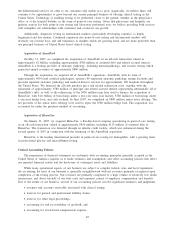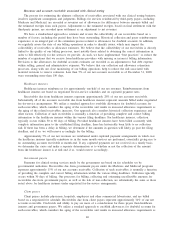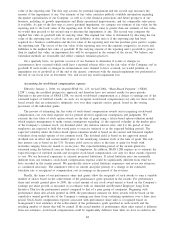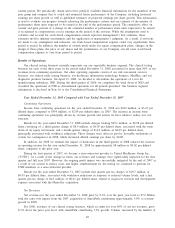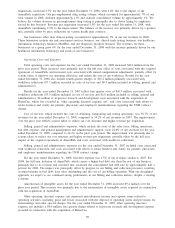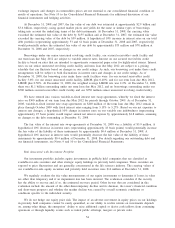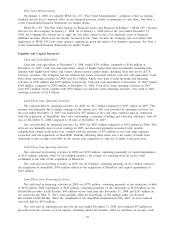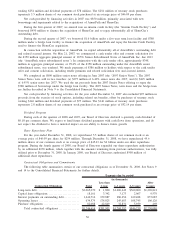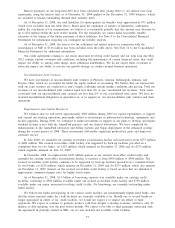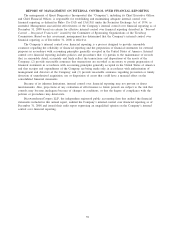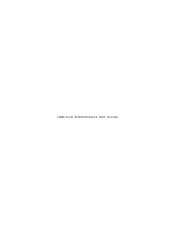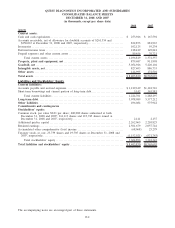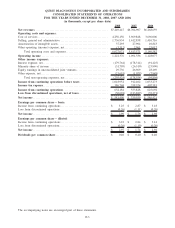Quest Diagnostics 2008 Annual Report Download - page 66
Download and view the complete annual report
Please find page 66 of the 2008 Quest Diagnostics annual report below. You can navigate through the pages in the report by either clicking on the pages listed below, or by using the keyword search tool below to find specific information within the annual report.exchange impacts and changes in commodities prices are not material to our consolidated financial condition or
results of operations. See Note 10 to the Consolidated Financial Statements for additional discussion of our
financial instruments and hedging activities.
At December 31, 2008 and 2007, the fair value of our debt was estimated at approximately $2.9 billion and
$3.6 billion, respectively, using quoted market prices and yields for the same or similar types of borrowings,
taking into account the underlying terms of the debt instruments. At December 31, 2008, the carrying value
exceeded the estimated fair value of the debt by $155 million and at December 31, 2007, the estimated fair value
exceeded the carrying value of the debt by $59 million. A hypothetical 10% increase in interest rates on our total
debt portfolio (representing approximately 53 and 61 basis points at December 31, 2008 and 2007, respectively)
would potentially reduce the estimated fair value of our debt by approximately $75 million and $78 million at
December 31, 2008 and 2007, respectively.
Borrowings under our senior unsecured revolving credit facility, our secured receivables credit facility and
our term loan due May 2012 are subject to variable interest rates. Interest on our secured receivables credit
facility is based on rates that are intended to approximate commercial paper rates for highly-rated issuers. Interest
rates on our senior unsecured revolving credit facility and term loan due May 2012 are subject to a pricing
schedule that can fluctuate based on changes in our credit ratings. As such, our borrowing cost under these credit
arrangements will be subject to both fluctuations in interest rates and changes in our credit ratings. As of
December 31, 2008, the borrowing rates under these credit facilities were: for our secured receivables credit
facility 3.6%; for our senior unsecured credit facility, LIBOR plus 0.40%; and for our term loan due May 2012,
LIBOR plus 0.50%. At December 31, 2008, the weighted average LIBOR rate was 2.2%. At December 31, 2008,
there was $1.1 billion outstanding under our term loan due May 2012, and no borrowings outstanding under our
$500 million secured receivables credit facility and our $750 million senior unsecured revolving credit facility.
We have entered into various variable-to-fixed interest rate swap agreements, whereby we fixed the interest
rates on $500 million of our term loan due May 2012 for periods through October 2009. As of December 31,
2008, variable-to-fixed interest rate swap agreements on $200 million of the term loan due May 2012 remain in
place through October 2009 with fixed interest rates ranging from 5.13% to 5.27%. Based on our net exposure to
interest rate changes, a hypothetical 10% change in interest rates on our variable rate indebtedness (representing
approximately 25 basis points) would impact annual net interest expense by approximately $2.8 million, assuming
no changes to the debt outstanding at December 31, 2008.
The fair value of the interest rate swap agreements at December 31, 2008 was a liability of $5.9 million. A
hypothetical 10% decrease in interest rates (representing approximately 18 basis points) would potentially increase
the fair value of the liability of these instruments by approximately $0.4 million at December 31, 2008. A
hypothetical 10% increase in interest rates would potentially decrease the fair value of the liability of these
instruments by approximately $0.4 million at December 31, 2008. For details regarding our outstanding debt and
our financial instruments, see Notes 9 and 10 to the Consolidated Financial Statements.
Risk Associated with Investment Portfolio
Our investment portfolio includes equity investments in publicly held companies that are classified as
available-for-sale securities and other strategic equity holdings in privately held companies. These securities are
exposed to price fluctuations and are generally concentrated in the life sciences industry. The carrying values of
our available-for-sale equity securities and privately held securities were $16 million at December 31, 2008.
We regularly evaluate the fair value measurements of our equity investments to determine if losses in value
are other than temporary and if an impairment loss has been incurred. The evaluation considers if the security
has the ability to recover and, if so, the estimated recovery period. Other factors that are considered in this
evaluation include the amount of the other-than-temporary decline and its duration, the issuer’s financial condition
and short-term prospects and whether the market decline was caused by overall economic conditions or
conditions specific to the individual security.
We do not hedge our equity price risk. The impact of an adverse movement in equity prices on our holdings
in privately held companies cannot be easily quantified, as our ability to realize returns on investments depends
on, among other things, the enterprises’ ability to raise additional capital or derive cash inflows from continuing
operations or through liquidity events such as initial public offerings, mergers or private sales.
54



